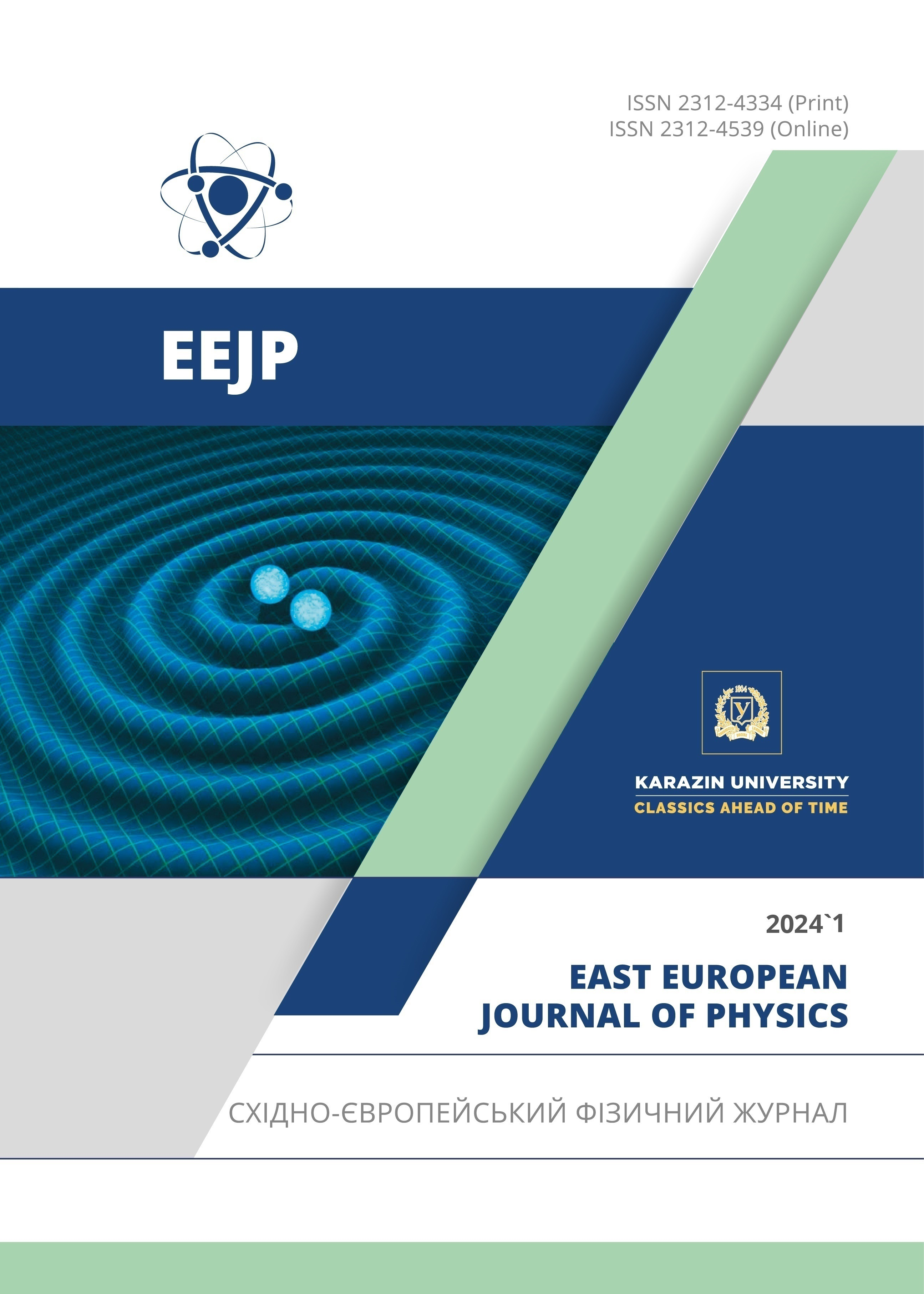Cosmic Aspects of Sharma-Mittal Holographic Dark Energy Model in Brans-Dicke Theory of Gravity
Abstract
We investigate the cosmological scenario involving spatially homogeneous and anisotropic Bianchi type-V I0 space-time in the context of the Sharma-Mittal holographic dark energy model within the framework of Brans-Dicke’s theory of gravitation. In order to achieve this objective, the Hubble, deceleration, equation-of-state parameters have been discussed. The deceleration parameter (q) is used to measure the pace at which the expansion of the universe is accelerating. The equation-of-state parameter (ωsmhde) characterizes the quintessence and vacuum areas of the universe. All the parameters demonstrate consistent behaviour following the Planck 2018 data. We assess the dynamical stability by defining the squared speed of sound and examining its behaviour. In addition, the energy conditions and the variation of ωsmhde and ω′smhde in the model indicate the present accelerating expansion of the universe.
Downloads
References
S. Perlmutter, et al., Astrophys. J. 517, 565 (1999). https://doi.org/10.1086/307221
A.G. Riess, et al., Astron. J. 116, 1009 (1998). https://doi.org/10.1086/300499
T. Koivisto, and D.F. Mota, Phys. Rev. D, 73, 083502 (2006). https://doi.org/10.1103/PhysRevD.73.083502
E.J. Copeland, et al., Int. J. Mod. Phys. D, 15, 1753 (2006). https://doi.org/10.1142/S021827180600942X
R.R. Caldwell, and M. Kamionkowski, Ann. Rev. Nucl. Part. Sci. 59, 397 (2009). https://doi.org/10.1146/annurev-nucl-010709-151330
K. Bamba, et al., Astrophys. Space Sci. 342, 155 (2012). https://doi.org/10.1007/s10509-012-1181-8
S. Nojiri, et al., Phys. Rept. 692, 1 (2017). https://doi.org/10.1016/j.physrep.2017.06.001
Q.G. Huang, M. Li, J. Cosmol. Astropart. Phys. 3, 1 (2005). https://doi.org/10.1088/1475-7516/2004/08/013
M. Li, Phys. Lett. B, 603, 1 (2004). https://doi.org/10.1016/j.physletb.2004.10.014
A. Cohen, and D. Kaplan, A. Nelson, Phys. Rev. Lett. 82, 4971 (1999). https://doi.org/10.1103/PhysRevLett.82.4971
L.N. Granda, and A. Oliveros, Phys. Lett. B, 671, 199 (2009). https://doi.org/10.1016/j.physletb.2008.12.025
H. Wei, and R.G. Cai, Phys. Lett. B, 660, 113 (2008). https://doi.org/10.1016/j.physletb.2007.12.030
S. Nojiri, and S.D. Odintsov, Gen. Rel. Grav. 38, 1285 (2006). https://doi.org/10.1007/s10714-006-0301-6
S. Nojiri, et al., Phys. Lett. B, 797, 134829 (2019). https://doi.org/10.1016/j.physletb.2019.134829
M. Tavayef, A. Sheykhi, K. Bamba, and H. Moradpour, Phys. Lett. B, 781, 195 (2018). https://doi.org/10.1016/j.physletb.2018.04.001
C. Tsallis, and L.J.L. Cirto, Eur. Phys. J. C, 73, 2487 (2013). https://doi.org/10.1140/epjc/s10052-013-2487-6
A.S. Jahromi et al., Phys. Lett. B, 780, 21 (2018). https://doi.org/10.1016/j.physletb.2018.02.052
H. Moradpour et al., Eur. Phys. J. C, 78, 829 (2018). https://doi.org/10.1140/epjc/s10052-018-6309-8
D.R.K. Reddy, et al., Astrophys Space Sci. 361, 356 (2016). https://doi.org/10.1007/s10509-016-2938-2
Y. Aditya, and D.R.K. Reddy, Eur. Phys. J. C, 78, 619 (2018). https://doi.org/10.1140/epjc/s10052-018-6074-8
V.U.M. Rao, et al., Results in Physics, 10, 469 (2018). https://doi.org/10.1016/j.rinp.2018.06.027
M.V. Santhi, et al., Int. J. Theor. Phys. 56, 362 (2017). https://doi.org/10.1007/s10773-016-3175-8
K.D. Naidu, et al., Eur. Phys. J. Plus, 133, 303 (2018). https://doi.org/10.1140/epjp/i2018-12139-2
Y. Aditya, et al., Eur. Phys. J. C, 79, 1020 (2019). https://doi.org/10.1140/epjc/s10052-019-7534-5
S. Maity, U. Debnath, Eur. Phys. J. Plus, 134, 514 (2019). https://doi.org/10.1140/epjp/i2019-12884-6
A. Iqbal, A. Jawad, Physics of the Dark Universe, 26, 100349 (2019). https://doi.org/10.1016/j.dark.2019.100349
G. Kaniadakis, Physica A: Stat. Mech. and its Appl. 296(3-4), 405 (2001). https://doi.org/10.1016/S0378-4371(01)00184-4
M. Masi, Phys. Lett. A, 338, 217 (2005). https://doi.org/10.1016/j.physleta.2005.01.094
E.M. Abreu, et al., EPL (Europhysics Letters), 124, 30003 (2018). https://doi.org/10.1209/0295-5075/124/30003
H. Moradpour, et al. Eur. Phys. J. C, 80, 1 (2020). https://doi.org/10.1140/epjc/s10052-020-8307-x
A. Jawad, and A.M. Sultan, Adv. High Energy Phys. 2021, 5519028 (2021). https://doi.org/10.1155/2021/5519028
U.K. Sharma, et al., IJMPD, 31, 2250013 (2022). https://doi.org/10.1142/S0218271822500134
N. Drepanou et al., ur. Phys. J. C, 82, 449 (2022). https://doi.org/10.1140/epjc/s10052-022-10415-9
J. Sadeghi, et al., arXiv:2203.04375 (2022). https://doi.org/10.48550/arXiv.2203.04375
O. Akarsu, and C.B. Kilinc, Astrophys. Space Sci. 326, 315 (2010). https://doi.org/10.1007/s10509-009-0254-9
C.L. Bennett, et al., Astron. Astrophys. Suppl. Ser. 148, 1 (2003). https://doi.org/10.1086/377252
D.R.K. Reddy, et al., Can. J. Phys. 97, 932 (2019). https://doi.org/10.1139/cjp-2018-0403
Y. Aditya, et al., Astrophys. Space Sci. 364, 190 (2019). https://doi.org/10.1007/s10509-019-3681-2
Y. Aditya, and D.R.K. Reddy, Astrophys. Space Sci. 364, 3 (2019). https://doi.org/10.1007/s10509-018-3491-y
Y. Aditya, et al., Ind. J. Phys. 95, 383 (2021). https://doi.org/10.1007/s12648-020-01722-6
R.L. Naidu, et al., Astrophys. Space Sci. 365, 91 (2020). https://doi.org/10.1007/s10509-020-03796-4
K.D. Naidu, et al., Mod. Phys. A, 36, 2150054 (2021). https://dx.doi.org/10.1142/S0217732321500541
Y. Aditya, et al., New Astr. 84, 101504 (2021). https://doi.org/10.1016/j.newast.2020.101504
Y. Aditya, et al., Int. J. Mod. Phys. A, 37, 2250107 (2022). https://doi.org/10.1142/S0217751X2250107X
M.P.V.V. Bhaskara Rao, et al., New Astr. 92, 101733 (2022). https://doi.org/10.1016/j.newast.2021.101733
U.Y.D. Prasanthi, and Y. Aditya, Phys. Dark Univ. 31, 100782 (2021). https://doi.org/10.1016/j.dark.2021.100782
U.Y.D. Prasanthi, and Y. Aditya, Results Phys. 17, 103101 (2020). https://doi.org/10.1016/j.rinp.2020.103101
Y. Aditya, and U.Y.D. Prasanthi, Bulg. Astr. Journal, 38, 52 (2023). https://astro.bas.bg/AIJ/issues/n38/YAditya.pdf
Y. Aditya, Bulg. Astr. Journal, 39, 12 (2023). https://astro.bas.bg/AIJ/issues/n39/YAditya.pdf
C.H. Brans, R.H. Dicke, Phys. Rev. 124, 925 (1961). https://doi.org/10.1103/PhysRev.124.925
C.B. Collins, et al., Gen. Relativ. Gravit. 12, 805 (1980). https://doi.org/10.1007/BF00763057
V.B. Johri, R. Sudharsan, Australian J. of Phys. 42(2), 215 – 222 (1989). https://doi.org/10.1071/PH890215
V.B. Johri, K. Desikan, Gen Relat Gravit 26, 1217–1232 (1994). http://dx.doi.org/10.1007/BF02106714
B.D. Sharma, D.P. Mittal, J. Math. Sci. 10, 28 (1975).
R. Caldwell, and E.V. Linder, Phys. Rev. Lett. 95, 141301 (2005). https://doi.org/10.1103/PhysRevLett.95.141301
N. Aghanim, et al., [Plancks Collaboration] arXiv:1807.06209v2 (2018). https://doi.org/10.48550/arXiv.1807.06209
P.A.R. Ade, et al., Astrophys. 571, A16 (2014). https://doi.org/10.1051/0004-6361/201321591
G.F. Hinshaw, et al., Astrophys. J. Suppl. 208, 19 (2018). https://doi.org/10.1088/0067-0049/208/2/19
Authors who publish with this journal agree to the following terms:
- Authors retain copyright and grant the journal right of first publication with the work simultaneously licensed under a Creative Commons Attribution License that allows others to share the work with an acknowledgment of the work's authorship and initial publication in this journal.
- Authors are able to enter into separate, additional contractual arrangements for the non-exclusive distribution of the journal's published version of the work (e.g., post it to an institutional repository or publish it in a book), with an acknowledgment of its initial publication in this journal.
- Authors are permitted and encouraged to post their work online (e.g., in institutional repositories or on their website) prior to and during the submission process, as it can lead to productive exchanges, as well as earlier and greater citation of published work (See The Effect of Open Access).








